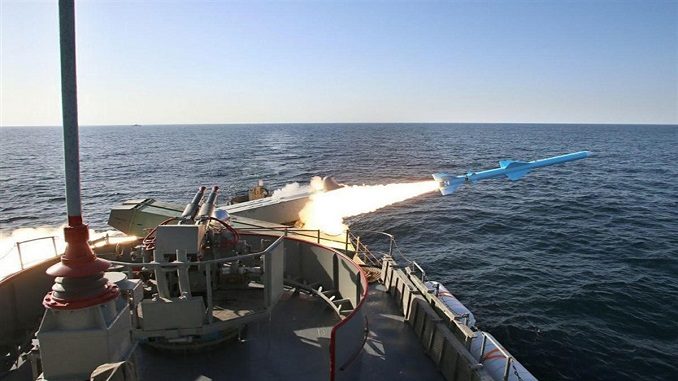
Iran’s second day of military drills continues Tuesday with testing of radar and surveillance systems to detect ground and aerial activities by the mock enemy, the spokesperson for the maneuvers said, Xinhua reports. The exercise will continue using missiles and artillery fire to eliminate the assumed threats, spokesperson Rear Admiral Lower Half Mahmoud Mousavi told Press TV on Tuesday.
On the second and final day of military exercises of Iranian Army, codenamed Mohammad Rasoulallah (Mohammad, the Prophet of God) which kicked off early on Monday, the Iranian forces test-fired two new surface-to-surface missiles. The vessels of the navy fired Ghadir long-range cruise missile for the first time, targeting the mock enemy vessel in a far distance of deep waters.
The missile is an advanced weapon with advantages like quick-to-launch feature, low-altitude fly, anti-electronic warfare feature, turning point option, and high-precision targeting, according to the spokesman of the drill. What makes the missile an awe-making advantage is its precision and high destructive power which were both assessed during the drill. Another missile test-fired during the drill was Nasr cruise missile which is a coast to water missile.
“Besides, short-range Nasr rockets along with medium-and long-range surface-to-surface missiles would be used to strike mock enemy targets,” Mousavi was quoted as saying.
Navy troops on board Azarakhsh and Shahab rocket-launching boats detonated the hypothetical enemy’s vessels and used Ra’ad assault vessels for mine-laying operation, while the coastal artillery exercised coast defense tactics, he added.
The purpose of the war game is to strengthen coordination among the Ground Force, Air Force, Navy and the Air Defense, the commander added. The war game covers vast areas south of Iran, mainly the coastline stretching to the southeastern Makran region, by the sea of Oman.
The Iranian army continued the exercises involving navy, ground force, the air force and the air defense unit on Tuesday. The exercises, code-named Muhammad Rasulullah-5, cover an expanse of 2.2 million square kilometers, including all of the Makran coasts and the Sea of Oman in the south of the country.
The Iranian Army has warned off two U.S.-led coalition battleships during the first day of military exercises involving ground, naval, and aerial forces in southern Iran. The military drills kicked off early on Monday on an order by Rear Admiral Habibollah Sayyari, the Army’s deputy commander for coordination. The exercises cover an expanse of three million square kilometers in the area in Iran’s south and southeast, the Makran Coast, and other areas in the Gulf of Oman.
The local military has claimed it threatened and chased off two U.S. ships during a series of war drills in the Sea of Oman. U.S. military officials have confirmed they were in contact with Iranian forces but still carried out their mission. But the Iranian military has claimed the ships were warned they had to leave the drills zone.
“This morning and in the first hour of the drills, two warships of the coalition which had approached the drills zone to monitor the Iranian Navy units were identified by the Navy drones. After declaring the issue to the drills’ tactical base, the patrolling and reconnaissance planes flew over the coalition warships and warned them to leave the region and the warships left the drill zone,” he said.
Relations between the U.S. and Iran appear to be at an all-time-low with both sides readying for conflict. Former Pentagon adviser Michael Rubin said Iran had a history of not respecting international waters.
“The problem with Iranian leadership is that they don’t understand that international waters are international,” he added.
